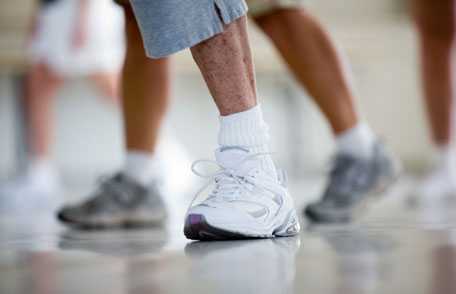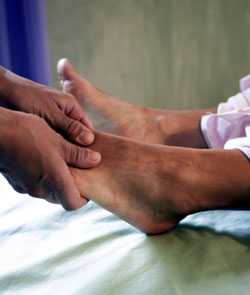Living with Diabetes: Keep Your Feet Healthy
 If you have diabetes, take care of your feet and the rest of your body.
If you have diabetes, take care of your feet and the rest of your body.
People with diabetes can develop serious problems with their feet that can affect how easily they can walk, and even can lead to amputation.
Many of these serious problems can be prevented by taking good care of your feet and your health. Manage your diabetes, including keeping your blood pressure, blood sugar (glucose) and cholesterol at levels your health care provider recommends.
- Don't smoke. Smoking reduces blood flow to the feet.
- Eat more fruits and vegetables.
- Stay at a healthy weight and be physically active every day.
- Take your medicines even when you feel good.
- Have your doctor give you a comprehensive foot exam every time you visit (at least four times a year).

Have your doctor give you a comprehensive foot exam every time you visit (at least four times a year).

Never walk barefoot or while wearing just socks. Wear slippers inside your home.

Trim your toenails after you’ve washed and dried your feet—the nails will be softer and safer to cut.
Latest Research
Research shows that diabetes often causes problems with feet and legs, and these problems can be severe.
In 2010 alone, about 73,000 adults with diabetes had a leg or foot amputated (removed from the body). Amputations in adults with diabetes account for about 60% of the amputations of legs and feet not resulting from an injury, such as from a car crash. Among those aged 45 years or older, people with diabetes were about ten times as likely to lose a leg or foot to amputation as people without diabetes, according to CDC research.
How Diabetes Can Hurt Your Feet
Diabetes can harm your feet in a number of ways. It reduces blood flow to certain areas of the body, especially the legs and feet, which makes it harder for your body to heal injuries. Diabetes nerve damage may cause you to no longer feel pain in your feet, and you may not realize you have a wound or injury that needs treatment.
Diabetic nerve damage appears to be more common in people with the following conditions:
- Problems controlling blood sugar levels.
- High cholesterol.
- High blood pressure.
- Overweight.
- Older than 40 years of age.
Warning Signs
If you experience any of these symptoms, contact your health care provider or a podiatrist (foot doctor) right away.
- You may feel pain in your legs or cramping in your buttocks, thighs, or calves during physical activity.
- Your feet may tingle, burn, or hurt.
- You may lose the sense of touch or not be able to feel heat or cold very well.
- The shape of your feet may change over time. You may lose hair on your toes, feet, and lower legs.
- The skin on your feet may become dry and cracked. The color and temperature of your feet may change.
- Your toenails may turn thick and yellow.
- Fungus infections such as athlete's foot may appear between your toes. You may have blisters, sores, ulcers, infected corns, and ingrown toenails.
Foot Care
Check your feet for sores and other injuries every day. You may have serious foot problems yet feel no pain.
- Always check between your toes and on the bottoms of your feet.
- Wash your feet every day. Dry them with care, especially between the toes.
- Trim your toenails (as needed) after you've washed and dried your feet—the nails will be softer and safer to cut.
Wear shoes that fit right and do not rub or pinch your feet, or cause blisters. New shoes should be comfortable at the time you buy them—don't expect them to stretch out. Always wear socks or stockings with your shoes. And never walk barefoot or while wearing just socks. Wear slippers inside your home.
Physical activity can help increase the circulation in your feet. There are many ways you can exercise your feet, even during times you're not able to walk. Ask your health care team about things you can do to exercise your feet and legs. And remember to have your doctor give you a comprehensive foot exam every time you visit (at least four times a year).
More Information
More Information
- CDC's Division of Diabetes Translation en español
- Chapter 9. Foot Problems, from the book Take Charge of Your Diabetes [1.3 MB], en español [2 MB]
- Healthy Feet Are Happy Feet [PODCAST – 02:23 minutes]
- Diabetes and You: Healthy Feet Matter! [539.23 KB]
- Take Care of Your Feet for a Lifetime , also available en español
- Feet Can Last a Lifetime: A Health Care Provider's Guide to Preventing Diabetes Foot Problems
- National Podiatric Medical Association
- Amputee Coalition
- Page last reviewed: April 20, 2015
- Page last updated: April 20, 2015
- Content source:
- National Center for Chronic Disease Prevention and Health Promotion, Division of Diabetes Translation
- Page maintained by: Office of the Associate Director for Communication, Digital Media Branch, Division of Public Affairs




 ShareCompartir
ShareCompartir